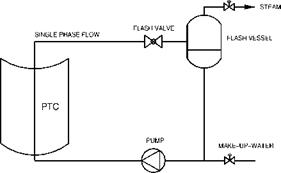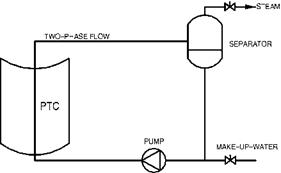Solar thermal collectors and applications
Solar steam generation systems
PTC are frequently employed for solar steam generation, because relatively high temperatures can be obtained without any serious degradation in the collector efficiency. Low temperature steam can be used in industrial applications, sterilisation, and for powering desalination evaporators.
Three methods have been employed to generate steam using PTC [160]:
1. The steam-flash concept, in which pressurised water is heated in the collector and then flashed to steam in a separate vessel.
2. The direct or in situ concept, in which two phase flow is allowed in the collector receiver so that steam is generated directly.
3. The unfired-boiler concept, in which a heat-transfer fluid is circulated through the collector and steam is generated via heat-exchange in an unfired boiler.
All these systems have certain advantages and disadvantages. In a steam-flash system, shown schematically in Fig. 39, water, pressurised to prevent boiling, is circulated through the collector and then flashed across a throttling valve into a flash vessel. Treated feedwater input maintains the level in the flash vessel and the subcooled liquid is recirculated through the collector. The in situ boiling concept, shown in Fig. 40, uses a similar system configuration without a flash valve. Subcooled water is heated to boiling and steam forms directly in the receiver tube. Capital costs associated with a direct-steam and a flash-steam system would be approximately the same [161].
|
Fig. 39. The steam-flash steam generation concept. |
|
|
|
Fig. 40. The direct steam generation concept. |
corresponding increase in system operating pressure to prevent boiling. Increased operating temperatures reduce the thermal efficiency of the solar collector. Increased pressures within the system require a more robust design of collector components, such as receivers and piping. The differential pressure over the delivered steam pressure required to prevent boiling is supplied by the circulation pump and is irreversibly dissipated across the flash valve. When boiling occurs in the collectors, as in an in situ boiler, the system pressure drop and consequently, electrical power consumption is greatly reduced. In addition, the latent heat - transfer process minimises the temperature rise across the solar collector. Disadvantages of in situ boiling are the possibility of a number of stability problems [162] and the fact that even with a very good feedwater treatment system, scaling in the receiver is unavoidable. In multiple row collector arrays, the occurrence of flow instabilities could result in loss of flow in the affected row. This in turn could result in tube dryout with consequent damage of the receiver selective coating. No significant instabilities were reported by Hurtado and Kast [161] when experimentally testing a single row 36 m system. Recently, once through systems are developed on a pilot scale for direct steam generation in which PTC are used inclined at 2-4° [163].
A diagram of an unfired boiler system is shown in Fig. 41. In this system, the heat-transfer fluid should be non-freezing and non-corrosive, system pressures are low and control is
straightforward. These factors largely overcome the disadvantages of water systems, and are the main reasons for the predominant use of heat-transfer oil systems in current industrial steam-generating solar systems.
The major disadvantage of the system result from the characteristics of the heat-transfer fluid. These fluids are hard to contain, and most heat-transfer fluids are flammable. Decomposition, when the fluids are exposed to air, can greatly reduce ignition-point temperatures, and leaks into certain types of insulation can cause combustion at temperatures that are considerably lower than measured self-ignition temperatures. Heat-transfer fluids are also relatively expensive and present a potential pollution problem that makes them unsuitable for food industry applications [164]. Heat-transfer fluids have much poorer heat-transfer characteristics than water. They are more viscous at ambient temperatures, are less dense, and have lower specific heats and thermal conductivities than water. These characteristics mean that higher flow rates, higher collector differential temperatures, and greater pumping power are required to obtain the equivalent quantity of energy transport when compared to a system using water. In addition, heat-transfer coefficients are lower, so there is a larger temperature differential between the receiver tube and the collector fluid. Higher temperatures are also necessary to achieve cost effective heat exchange. These effects result in reduced collector efficiency.
For every application the suitable system has to be selected by taking into consideration all the above factors and constrains.

